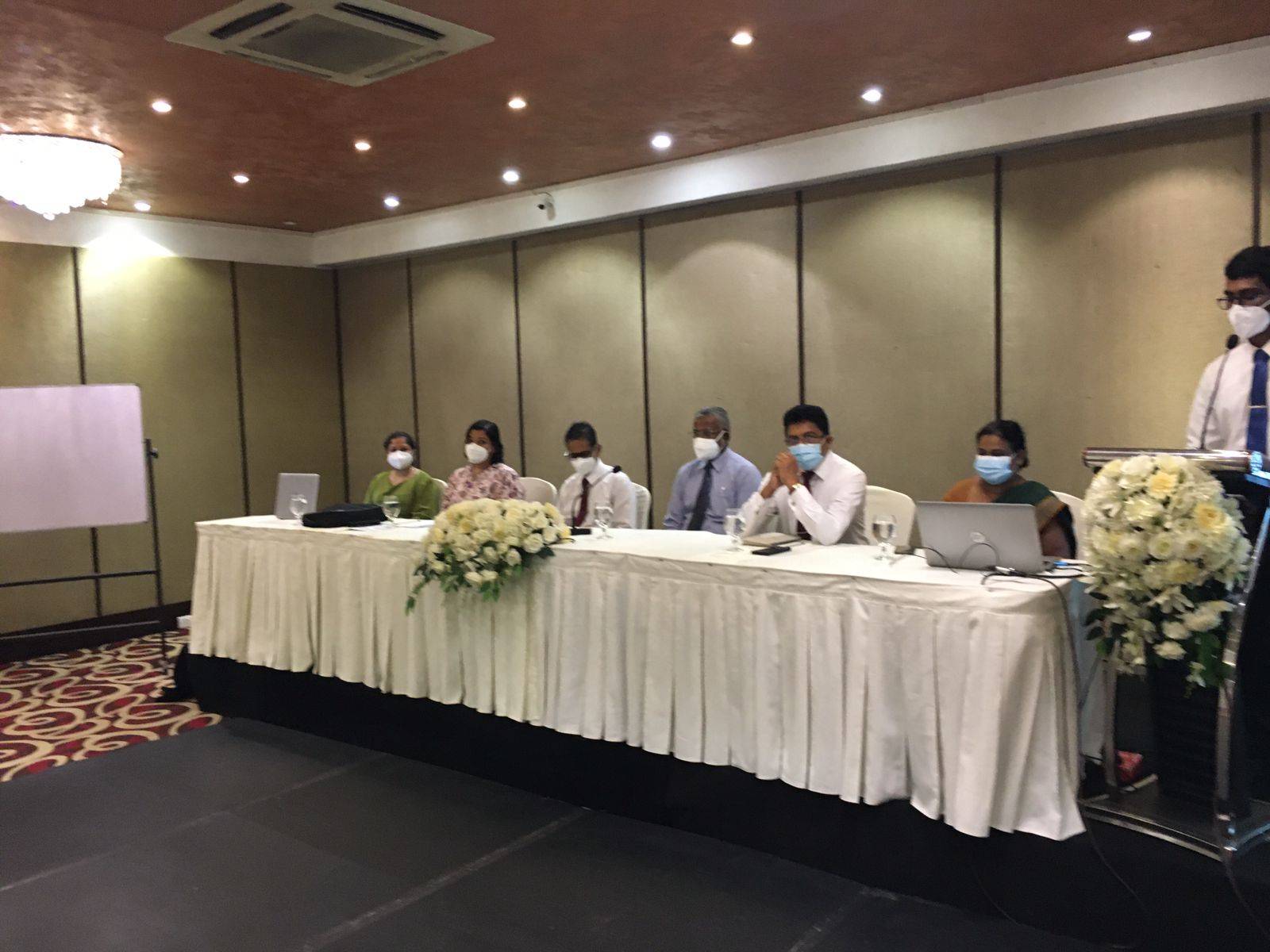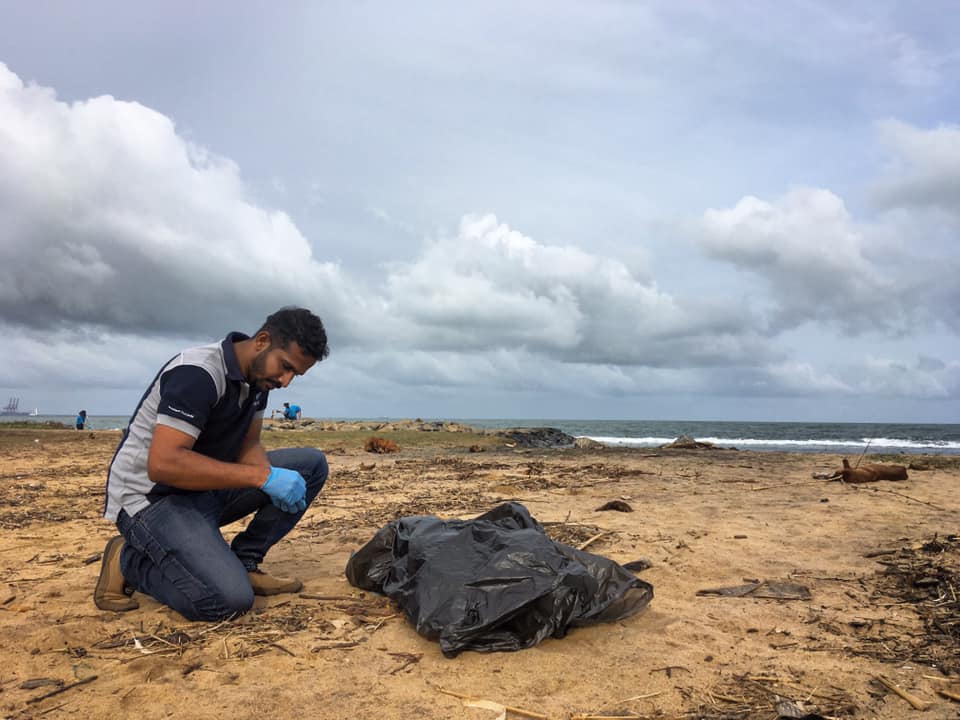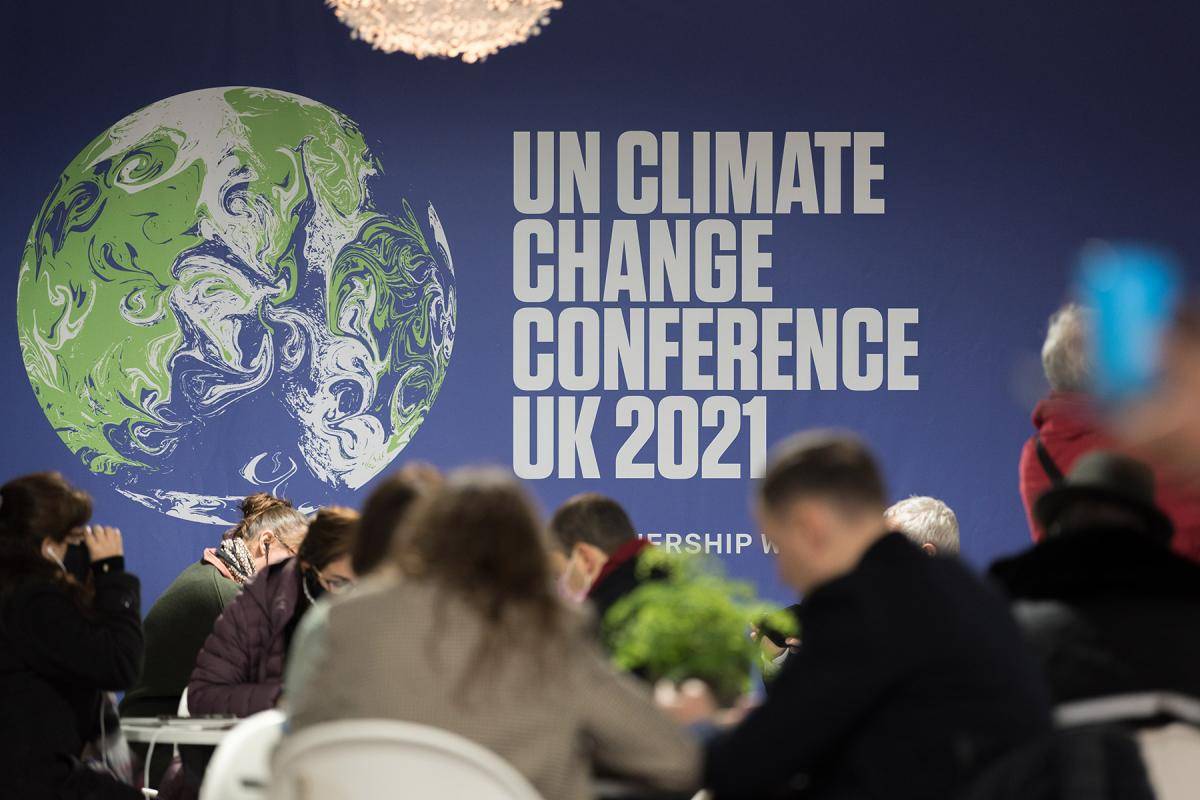
A Capacity Building Tool-kit for Collectors/Recyclers
The Project “Enhancing Extended Producer Responsibility (EPR) through a Public-Private Partnership Approach” which is implemented by the Ceylon Chamber of Commerce (CCC) in partnership with Biodiversity Sri Lanka (BSL) with the endorsement of the Ministry of Environment (MoE) conducted a Training of Trainers workshop to introduce a Capacity Building Toolkit on waste collection/ recycling to the field staff of the Central Environmental Authority (CEA) and the Western Provincial Waste Management Authority (WPWMA) on February 25, 2022, at Grand Monarch, Thalawathugoda.
The main objective of the workshop was to impart knowledge on plastic waste collection and recycling among the staff of CEA and WPWMA and through them transfer knowledge to collectors/ recyclers in Sri Lanka. The trained persons will conduct a series of training programs targeting collectors and recyclers registered with CEA and WPWMA. This Capacity Building Toolkit was developed with the support of the National Cleaner Production Centre – Sri Lanka (NCPC Sri Lanka) under the USAID-funded Municipal Waste Recycling Project (MWRP).
Mr. Chandrarathna D Vithanage, Senior Assistant Secretary-General, CCC/Project Manager welcomed the participants and Ms. Nihani Riza, Project Management Specialist from the Office of Economic Growth, USAID Mission and Eng. J. M. U. Indrarathne, Deputy Director-General, Waste Management Division, CEA delivered opening remarks. Ms. Riza provided a quick overview of USAID’s efforts in tackling plastic waste issues globally. She was thankful to the Clean Cities Blue Ocean (CCBO) Program’s partners for contributing to achieve the goals of sustainable consumption and production, waste management, pollution reduction, climate change mitigation, and human health advancement. Mr. Indrarathne emphasized on the negative impacts that plastics generate on ecology across the world. He stated that Sri Lanka has enacted several regulations between 2017 and 2020 to address the plastic waste issue. Whilst recognizing the importance of the toolkit to build technical capabilities and financial prospects of collectors/ recyclers in Sri Lanka, he thanked USAID, the CCBO project, and the CCC for undertaking this all-important initiative.
The resource personnel from NCPC introduced the Capacity Building Toolkit to the participants. Following the introductory presentation, group work enabled the participants to present various chapters of the toolkit. The objective of this session was to ensure familiarity with its contents. The post-lunch session was entirely dedicated to a group case study on recycling operations. The participants were asked to identify regulatory matters, technical and financial considerations, environmental and social aspects, and cost calculations of recycling operations based on the details given in the case study. All the groups calculated cost efficiencies correctly and some of them came up with economically viable suggestions through which the cost of recycling operations can be reduced.
The workshop saw active and enthusiastic participation of the CEA and WMA staff. One of the highlights was when making presentations by the participants, using examples from their practical experiences, which is a positive case in transmitting knowledge to collectors and recyclers. During the last session of the workshop, a plan was discussed to organize three capacity-building workshops for collectors and recyclers in Colombo, Gampaha, and Kalutara Districts during the next two months.

We recently celebrated the International Day of Women and Girls in Science and International Women’s Day: In this edition we look at Women in Conservation – Easy or not so easy?
Why do we always want to highlight women in different roles? Why cannot we talk about people in conservation in general? As people who want to do something different, to make a change. Born and raised in a region like ours we put things differently, don’t we? Cultural and social norms play a huge part – in challenging women in unconventional job roles. Even though the world is changing in the way men and women are seen in different job roles, we do see them as men and women!
Due to personal commitments and raising a family – most women give up or take a break from their work. Some return, some don’t. There is even a certain age that women need to “settle down”. Often when women stay single, it is frowned upon. Many female graduates end up in desk jobs rather than working in the field. Because as they say – women are born to do documentation and not implementation!
Having both men and women working together is essential for conservation, sharing knowledge, and taking on different roles and responsibilities. But many organizations, authorities, and others exclude women from participating, especially in decision-making roles. Hence the critical need for having both men and women working together for sustainable management of natural resources is missed. There is also the fact that on many occasions, women tend to wait for the opportunity to be given and not take to speaking up – thus likely to be in the background not voicing their opinion. A reason to lose opportunities
Women naturally bond with nature – they are caregivers, bearers of children, nurturers, and a must add-on – getting things done one way or the other. Therefore, women need to be equally and actively involved in processes of conservation as they play a critical role as land managers and resource users. Simply put, effective conservation is not possible without the voices, knowledge, solutions, and contributions of women – especially since they do makeup half of the world’s population. The adaptive capabilities of women make them important resources in addressing climate and environmental challenges.
Being a conservationist or a field researcher is not easy for any person. There is a lot of hard work and commitment put into it. If both males and females equally put in their commitment 100%, then each should get equal opportunities. Unfortunately, this is not the case as at many events – women must make an extra effort to come to a position. This is debatable, but obvious when you see statistics and the roles played by women in conservation in the field and at leading roles – making up less than 30% in research alone.
A woman’s role in conserving biodiversity plays a significant part as they know how to manage resources more sustainably; take our mothers as a very strong example. In terms of influencing – the home is the best place to raise people to be more conscious, share and care about each other more: for women, these are natural instincts and capabilities to build a resilient family unit.
Thus, educating not only girls but also boys in conservation is a must. Educating that there are differences between men and women is all right – it is a must. Educating and creating awareness that both men and women can share the same job role on many occasions, that some can be better at it and to pay respect to each other is also a must. We need to learn that without working together, we cannot fight against wildlife crime, and climate change, eradicate poverty or simply live a healthy sustainable life.
Written by Mega Ganeshan

Giving LIFE to Our Beaches – A Public – Private – Community Partnership
As an island nation, Sri Lanka boasts of a coastline extending over 1,300km. A little-known fact is that our coastal and marine area is approximately 8 times the total land area of our country. With 103 rivers debouching into the ocean, approximately 85% of marine litter, originates from mismanaged, land-based, human activities. With a wave and tidal action, this litter accumulates on beaches posing threats and risks to industries and livelihoods that depend upon them as well as to the general aesthetic beauty of our island nation – known the world over as a beach paradise!
To maximize sustainable utilization of our beaches, it is imperative that we take measures to keep them clean and free of hazards allowing for free public movement and recreation. The solid waste which is found on our shores is often not only of local origin but also washed up from overseas. Plastic, glass, aluminum, and rubber-based material, if collected and directed appropriately, can be turned into valuable resources through upcycling and recycling. Mismanagement of plastic waste can result in leaching and the generation of microplastics, which via the food chain can re-accumulate, threatening the safety and wellbeing of coastal and marine fauna. It is also an imminent health hazard.
Given that urgent action is needed to ensure that our beaches are constantly monitored, cleaned, and managed sustainably – with the involvement of all stakeholders, BSL led by the Marine Environment Protection Authority (MEPA) has launched Life to Our Beaches – a program to clean and maintain selected beach stretches. Community involvement is an indispensable component in maintaining beaches. It is an opportunity for local coastal communities to generate an additional income whilst contributing to a worthy national cause. It is not just collecting trash from the beaches. It goes beyond sensitizing and educating coastal communities on solid waste management whilst contributing to improving their living standards.
Community members, who will act as beach caretakers under this program, are Samurdhi beneficiaries. They will be trained on waste collection and segregation. The collected recyclable/ reusable plastic waste will be sold to recyclers so that community members can directly gain an additional income. Increasing plastic waste collection will also contribute to increasing national plastic waste recycling rates, which are currently significantly low. This will also improve circular economic activities. When coastal stretches are maintained clean and healthy, local, and international visitors will make frequent visits to these destinations so that associated communities can set up new businesses targeting visitors. This will be a boost to the local economy.
We invite you to join hands with BSL in its Life to Our Beaches Program – Contact us for more information.

BSL’s Biodiversity Project Ranking Scheme (BPRS) – a pathway to sustainable projects!
BSL urges all companies engaged in biodiversity-related projects to get them ranked, thus improving designing, implementation, and monitoring.
As in other Asian economies, in Sri Lanka, the private sector is the engine of growth. Sustaining high economic growth rates and improving the lives of the poor or marginalized communities whilst not compromising on environmental conservation and management is one of the biggest challenges facing growing economies. Many of the services that biodiversity and ecosystems provide are currently severely threatened. Safeguarding Sri Lanka’s biological diversity is integral to sustainable development, competitiveness, economic growth, and employment.
Some of the larger multinational and national companies operating in the country have included environmental and social dimensions into their growth agenda. A scoping study undertaken by Biodiversity Sri Lanka (BSL) in 2018 revealed that the private sector is increasingly taking an active role in environmental sustainability and biodiversity conservation issues both within and outside of its core business. Most initiatives in this direction are either carried out internally by companies themselves with the assistance of specialized non-governmental organizations, or by direct links with state institutions. Significant advancements have been made and some best practices and outstanding projects have been recognized by recent award schemes. These worthy examples have displayed sustained commitment, serving as inspirations to others. However, it is recognized that a large number of projects still do not realize their intended goals and objectives, leaning towards non-optimum use of much needed resources.
Much of these projects are designed on the assumption that they will lead to conservation of key biological resources. Hence, monitoring, evaluation, and assessment are primary tools to determine whether they are meeting intended targets and objectives. Such assessments may also serve as useful reference materials for government agencies, non-governmental organizations, and others involved in the design, implementation, or evaluation of biodiversity/ environmental projects. Thus, more attention must be paid to drive the private sector to incorporate well-defined scientific approaches in projects, devise action plan-based operations including community involvement, and achieving core objectives by defining suitable methodologies that recognizes the importance of these projects in addressing national biodiversity conservation priorities
In this context, Biodiversity Sri Lanka’s (BSL) Biodiversity Project Ranking Scheme (BPRS) was developed to aid private sector companies in improving the design and implementation of biodiversity conservation-related projects. This scheme endeavors to ensure that private sector-led biodiversity conservation projects, support national conservation efforts and maximizes the positive impacts of such projects on conserving and managing the country’s national biological heritage. A Project Ranking Support Manual aims at helping project planners, managers, implementers, and monitors to further understand the BPRS criteria, and to assist in ensuring that the design and implementation of a project is in line with the requirements of the scheme. Through pilot testing, this scheme has been refined to enable users to utilize it not only as a means of ranking projects nearing completion or are in its final stages but also in project design.
Following the audit of a project by our Auditor Bank of eminent scientists, respective companies will be awarded a Star Rank and exclusive use of the Project Ranking Logo.
Do not miss this valuable opportunity – Contact us!

COP 26 – What Next!
By the end of COP26 of the United Nations Framework Convention on Climate Change (UNFCC), held in Glasgow, UK in November 2021, 151 countries had submitted new climate plans, known as nationally determined contributions, or NDCs to slash their carbon emissions by 2030. To keep the goal of limiting temperature rise to 1.5 degrees C within reach, we need to cut global emissions in half by the end of this decade. In contrast, the United Nations calculates that these plans, as they stand, but the world on track for 2.5 degrees C warming by the end of the century. That is better than the 4 degrees C trajectory the world was on before the Paris Agreement was struck, but still extremely dangerous.
But some 2030 targets of major emitters, particularly those from Australia, China, Saudi Arabia, Brazil, and Russia are so weak that they don’t offer credible pathways to achieve their net-zero targets. The Glasgow decision calls on countries to “revisit and strengthen” their 2030 targets by the end of 2022 to align them with the Paris Agreement’s temperature goals. In addition, the pact asks nations to consider further actions to curb potent non-CO2 gases, such as methane, and includes language emphasizing the need to “phase down unabated coal” and “phase-out fossil fuel subsidies.” This marked the first-time negotiators have explicitly referenced shifting away from coal and phasing out fossil fuel subsidies in the COP decision text.
This COP finally recognized the importance of nature for both reducing emissions and building resilience to the impacts of climate change, both in the formal text and also through a raft of initiatives announced on the sidelines. Once we see major emitters’ new climate targets by the end of 2022, we will have a much better idea of whether we will be able to avoid breaching that temperature threshold — and if we do breach it, by how much.
Financial Support for Developing Counties
- In 2009, rich nations committed to mobilizing $100 billion a year by 2020 and through 2025 to support climate efforts in developing countries. Developed countries failed to meet that goal in 2020. The COP26 outcome made it clear that these countries have not fulfilled this goal and stipulated that those countries must report on their progress. The post-2025 climate finance goal is expected to be set by 2024.
- Developed countries also agreed to at least double funding for adaptation by 2025, which would amount to at least $40 billion. This is a significant milestone to address the imbalance between funding for mitigation and adaptation efforts; adaptation finance currently amounts to only a quarter of total climate finance, while need to adapt to the increasing impacts of the climate crisis continues to grow.
- The Adaptation Fund reached unprecedented levels of contributions, with new pledges for $356 million that represent almost three times its mobilization target for 2022.
- COP26 also took steps to help developing countries access good quality finance options. For example, encouraging multilateral institutions to further consider the links between climate vulnerabilities and the need for concessional financial resources for developing countries — such as securing grants rather than loans to avoid increasing their debt burden.
Loss and Damage
COP26 finally put the critical issue of loss and damage squarely on the main stage. Climate change is already causing devastating losses of lives, land, and livelihoods. Some damages are permanent — from communities that are wiped out, to islands disappearing beneath the waves, to water resources that are drying up. Loss and damage are likely to be one of the bigger issues leading up to the COP27 summit in Egypt next year.
Significant outside the negotiations
- a bold commitment from India to reach net-zero emissions by 2070 including ambitious renewable energy targets for 2030)
- 109 countries signed up to the Global Methane Pledge to slash emissions by 30% by 2030
- A pledge by 141 countries to halt and reverse forest loss by 2030 (backed by $18 billion in funding, including $1.7 billion dedicated to support indigenous peoples).
- The UK announced the Glasgow Breakthroughs, a set of global targets meant to dramatically accelerate the innovation and use of clean technologies in five emissions-heavy sectors: power, road transport, steel, hydrogen, and agriculture
Where do we go from here?
- In the year ahead, major emitters need to ramp up their 2030 emissions reduction targets to align with 1.5 degrees C
- more robust approaches are needed to hold all actors accountable for the many commitments made in Glasgow, and much more attention is needed on how to meet the urgent needs of climate-vulnerable countries to help them deal with climate impacts and transition to net-zero economies.
- The Glasgow Climate Pact outlines the key steps to do so. But it is only once this is achieved that we will truly have a shot at reaching the 1.5 degrees C goal and building a safer and more just future for us all.
By the end of this century, Sri Lanka is likely to see an increase of 2-3 °C average temperature rise. There is likely to be significant inundation all around the coast, particularly in places like Negombo and Galle. The country has seen a historical increase, in both the number and intensity of droughts, floods, geographic changes, vector-borne diseases, coastal erosion, tropical storms, lightning, crop failures, landslides, and siltation of reservoirs. All of these are related, at least partially, to temperature and rainfall changes. These events have devastating and adverse impacts on our environment, citizens, infrastructure, businesses, and the national budget. The rising costs of climate change are being and will be, borne by the Sri Lankan public and by corporations that suffer damage. It is also being borne by future generations as the country increases its debt burden on this account. Likely, an inequitable proportion of these losses will be borne by poor and marginalized citizens, living along the banks of canals, rivers, and along the coast or residing in landslide-prone areas. Sri Lanka has little choice but to prepare for and adapt to climate change. Sri Lanka’s greenhouse gas emissions are minuscule in comparison to those of developed nations, India, or China. Climate We cannot stop climate change on our own, but we can prepare for it, safeguard ourselves from it, mitigate its impacts, and where we are the winners of climate change, we can capitalize and make the best of it.
What’s for Business
Over half of the UK’s largest businesses have committed to eliminate their contribution to carbon emissions by 2050. The UK government is calling on the global private sector to follow the UK’s example and join the UN Race to Zero. As of today, 60 of the UK’s FTSE 100 companies have signed up to the United Nation’s Race to Zero campaign – the largest ever global alliance committed to achieving net-zero carbon emissions by 2050 at the latest
Globally, over 5,200 companies of all sizes have now joined the UN Race to Zero, representing sectors like transport, technology, manufacturing, retail, and finance. Nearly half of these are British businesses, with the UK private sector demonstrating international leadership in global efforts to tackle climate change. The Race to Zero acts as a kickstart for companies going green, guiding their actions in the transition to net-zero and positioning businesses at the forefront of the global race to develop new green technology, kick-start new industries, and attract private investment. Businesses both large and small, across all sectors of the global economy, have a crucial role to play in both reducing their environmental impact and developing the green technologies that will set us on the path to net-zero.
Over 2,000 small businesses from across the UK have pledged to reduce their emissions and join the Race to Zero through the Together for Our Planet Business Climate Leaders campaign, launched to help small businesses go green. Acting on climate change will help businesses:
- grow
- seize new opportunities
- create new jobs,
- encourage investment
- adapt against the challenges of a changing planet
- reducing emissions can lower businesses’ running costs, save them money
- attract new customers
- maintain a competitive advantage locally and globally.
The commitments must build on the government’s Net Zero Strategy, which outlines measures to transition to a green and sustainable future.
- to take urgent action and demonstrate their climate leadership by signing-up to Race to Zero and setting out clear pathways to get to net zero.
- make tangible climate commitments that helps chart our path to net zero emissions by 2050.
- grasp the economic opportunities
- Step up to drive the innovation needed
- Net Zero awards – a competition launched to find the best small businesses taking innovative steps to cut greenhouse gas emissions. The Heroes of Net Zero Awards
We must make collective efforts to encourage businesses to go green. We call on all businesses, of all sizes, to pledge to go One Step Greener and sign up to the globally-recognized UN Race to Zero Climate Commitment so, they can protect the planet and their business, and help us start a green business revolution.







